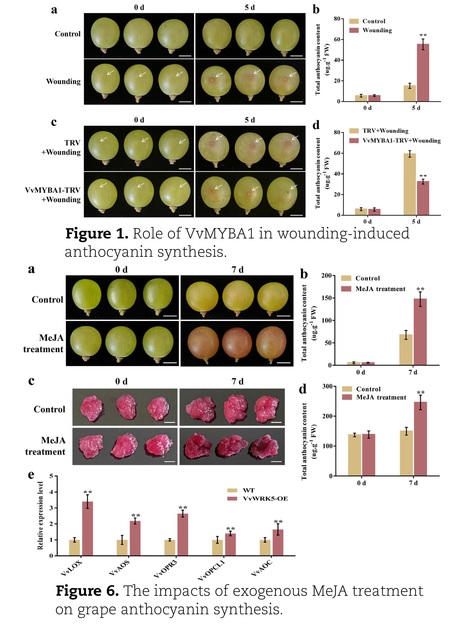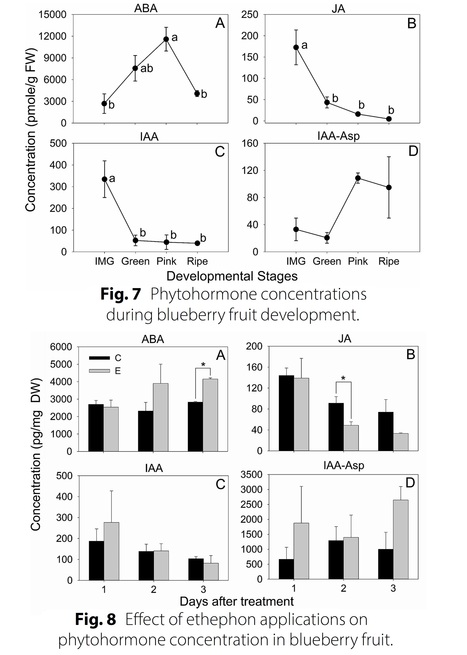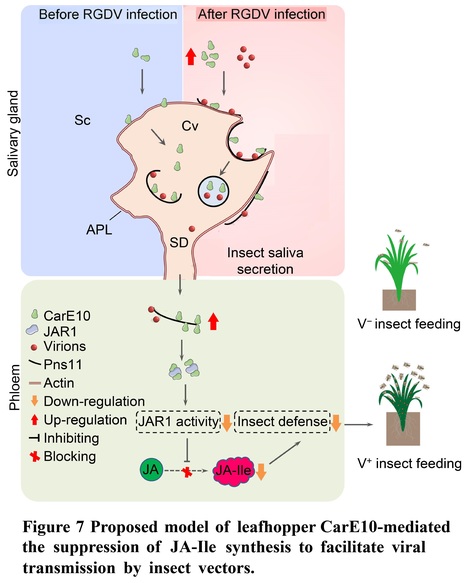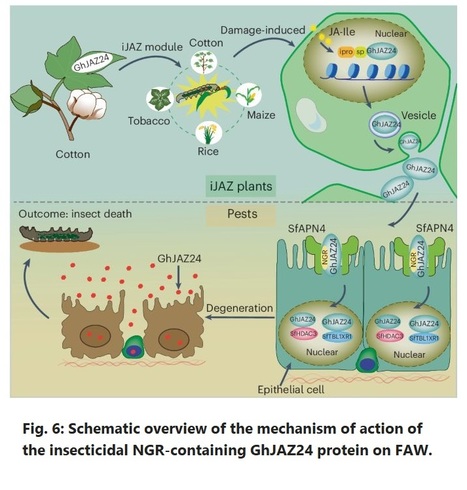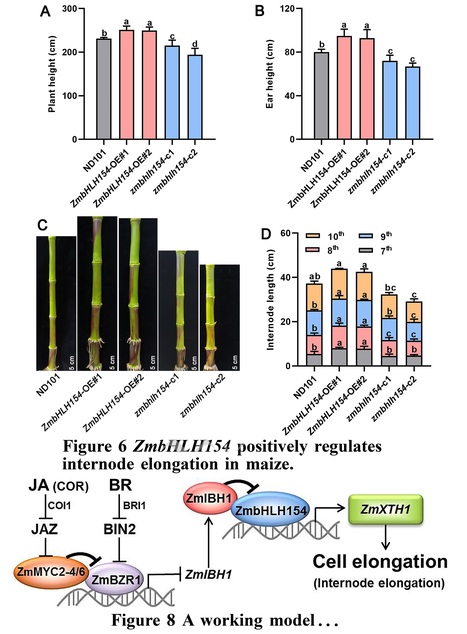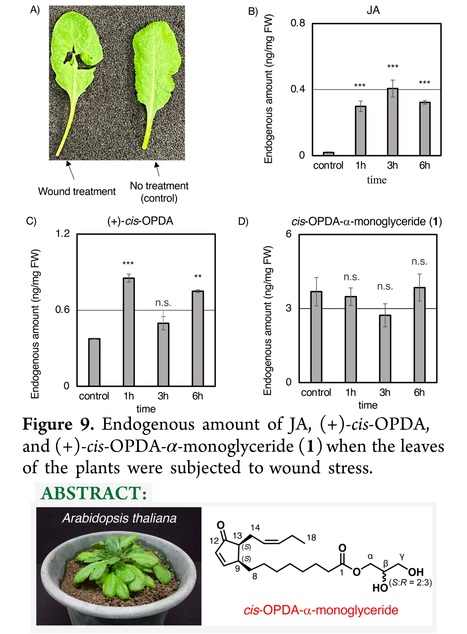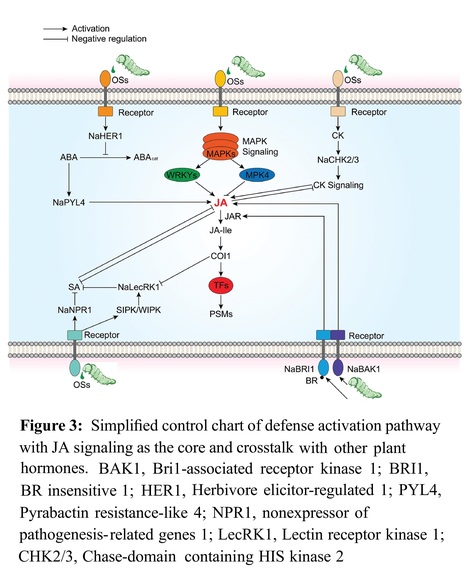 Your new post is loading...
 Your new post is loading...
Authors: Takuya Kaji, Yuho Nishizato, Hidenori Yoshimatsu, Akiyoshi Yoda, Wenting Liang, Andrea Chini, Gemma Fernández-Barbero, Kei Nozawa, Junko Kyozuka, Roberto Solano and Minoru Ueda.
iScience (2024)
Highlights: • Δ4-dn-iso-OPDA is identified as the major bioactive isomer of Δ4-dn-OPDAs. • Δ4-dn-iso-OPDA is biosynthesized through isomerization of Δ4-dn-cis-OPDA in M. polymorpha. • Δ4-dn-OPDAs are distributed in bryophyte lineages, including a liverwort, a moss, and a hornwort.
Abstract: "Significant progress has been recently made in our understanding of the evolution of jasmonates biosynthesis and signaling. The bioactive jasmonate activating COI1-JAZ co-receptor differs in bryophytes and vascular plants. Dinor-iso-12-oxo-phytodienoic acid (dn-iso-OPDA) is the bioactive hormone in bryophytes and lycophytes. However, further studies showed that the full activation of hormone signaling in Marchantia polymorpha requires additional unidentified hormones. Δ4-dn-OPDAs were previously identified as novel bioactive jasmonates in M. polymorpha. In this paper, we describe the major bioactive isomer of Δ4-dn-OPDAs as Δ4-dn-iso-OPDA through chemical synthesis, receptor binding assay, and biological activity in M. polymorpha. In addition, we disclosed that Δ4-dn-cis-OPDA is a biosynthetic precursor of Δ4-dn-iso-OPDA. We demonstrated that in planta cis-to-iso conversion of Δ4-dn-cis-OPDA occurs in the biosynthesis of Δ4-dn-iso-OPDA, defining a key biosynthetic step in the chemical evolution of hormone structure. We predict that these findings will facilitate further understanding of the molecular evolution of plant hormone signaling."
Authors: Xiaodi Wang, Xuqing Luo, Jianyang Guo, Nianwan Yang, Fanghao Wan, Zhichuang Lü and Wanxue Liu.
iScience (2024)
Highlights: • REPAT38 induces stomatal closure • REPAT38 inhibits the synthesis of JA, ET and ABA • REPAT38 inhibits the expression of plant hormone-responsive genes • REPAT38 acts as an effector to weaken host plant defense
Abstract: "Insects have evolved effectors to regulate host defenses for efficient feeding, yet their impact on chewing insects, like the tomato leaf miner (Phthorimaea absoluta), a significant pest, is poorly understood. We used RNAi to target the REPAT38 gene in larvae, monitoring changes at 0.5, 1, 2, and 4 h in leaf stomata, plant hormone concentrations (jasmonic acid (JA), jasmonoyl-L-isoleucine (JA-Ile), salicylic acid (SA), ethylene (ET), and abscisic acid (ABA)), and 12 hormone-responsive genes to explore the molecular mechanism of REPAT38-mediated plant-insect interactions. The results showed that the effector induced stomatal closure at 0.5 h and inhibited the synthesis of JA, ET, and ABA at 1 h. Additionally, seven plant hormone-responsive genes—AOC, MYC2, ACS1A, PAL, PR1, EIL2, and SRK2E—were inhibited at various time points. Our data suggest that REPAT38, as an effector with conserved functions, can weaken tomato host defenses and conducive to insect adaptation to host plants."
Authors: Leila Feiz, Christine Shyu, Shan Wu, Kevin R. Ahern, Iram Gull, Ying Rong, Caroline J. Artymowicz, Miguel A. Piñeros, Zhangjun Fei, Thomas P. Brutnell and Georg Jander.
The Plant Cell (2024)
One-sentence summary: Hormonal regulation of maize stalk height is influenced by four members of a gene family that has similarity to genes previously associated with insect defense induction in numerous other plant species.
Abstract: "The F-box protein Coronatine Insensitive (COI) is a receptor for the jasmonic acid signaling pathway in plants. To investigate the functions of the six maize (Zea mays) COI proteins (COI1a, COI1b, COI1c, COI1d, COI2a, and COI2b), we generated single, double, and quadruple loss-of-function mutants. The pollen of the coi2a coi2b double mutant was inviable. The coi1 quadruple mutant (coi1-4x) exhibited shorter internodes, decreased photosynthesis, leaf discoloration, microelement deficiencies, and accumulation of DWARF8 and/or DWARF9, two DELLA family proteins that repress the gibberellic acid signaling pathway. Co-expression of COI and DELLA in Nicotiana benthamiana showed that the COI proteins trigger proteasome-dependent DELLA degradation. Many genes that are downregulated in the coi1-4x mutant are gibberellic acid-inducible. In addition, most of the proteins encoded by the downregulated genes are predicted to be bundle sheath- or mesophyll-enriched, including those encoding C4-specific photosynthetic enzymes. Heterologous expression of maize Coi genes in N. benthamiana showed that COI2a is nucleus-localized and interacts with maize jasmonate ZIM (zinc-finger inflorescence meristem) domain (JAZ) proteins, the canonical COI repressor partners. However, maize COI1a and COI1c showed only partial nuclear localization and reduced binding efficiency to the tested JAZ proteins. Together, these results show the divergent functions of the six COI proteins in regulating maize growth and defense pathways."
Authors: Zhen Zhang, Cui Chen, Changyue Jiang, Hong Lin, Yuhui Zhao and Yinshan Guo.
Horticulture Research (2024)
Abstract: "Wounding stress induces the biosynthesis of various secondary metabolites in plants, including anthocyanin. However, the underlying molecular mechanism remains elusive. Here, we reported that a transcription factor, VvWRKY5, promotes wounding-induced anthocyanin accumulation in grape (Vitis vinifera). Biochemical and molecular analyses demonstrated that wounding stress significantly increased anthocyanin content, and VvMYBA1 plays an essential role in this process. VvWRKY5 could interact with VvMYBA1 and amplify the activation effect of VvMYBA1 on its target gene VvUFGT. The transcript level of VvWRKY5 was notably induced by wounding treatment. Moreover, our data demonstrated that VvWRKY5 could promote the synthesis of jasmonic acid (JA), a phytohormone that acts as a positive modulator in anthocyanin accumulation, by directly binding to the W-box element in the promoter of the JA biosynthesis-related gene VvLOX and enhancing its activities, and this activation was greatly enhanced by the VvWRKY5-VvMYBA1 protein complex. Collectively, our findings show that VvWRKY5 plays crucial roles in wounding-induced anthocyanin synthesis in grape and elucidates the transcriptional regulatory mechanism of wounding-induced anthocyanin accumulation."
Authors: Yi-Wen Wang and Savithri U. Nambeesan.
BMC Plant Biology (2024)
Abstract: "Background - Blueberry fruit exhibit atypical climacteric ripening with a non-auto-catalytic increase in ethylene coincident with initiation of ripening. Further, application of ethephon, an ethylene-releasing plant growth regulator, accelerates ripening by increasing the proportion of ripe (blue) fruit as compared to the control treatment. To investigate the mechanistic role of ethylene in regulating blueberry ripening, we performed transcriptome analysis on fruit treated with ethephon, an ethylene-releasing plant growth regulator. Results - RNA-Sequencing was performed on two sets of rabbiteye blueberry (‘Powderblue’) fruit: (1) fruit from divergent developmental stages; and (2) fruit treated with ethephon, an ethylene-releasing compound. Differentially expressed genes (DEGs) from divergent developmental stages clustered into nine groups, among which cluster 1 displayed reduction in expression during ripening initiation and was enriched with photosynthesis related genes, while cluster 7 displayed increased expression during ripening and was enriched with aromatic-amino acid family catabolism genes, suggesting stimulation of anthocyanin biosynthesis. More DEGs were apparent at 1 day after ethephon treatment suggesting its early influence during ripening initiation. Overall, a higher number of genes were downregulated in response to ethylene. Many of these overlapped with cluster 1 genes, indicating that ethylene-mediated downregulation of photosynthesis is an important developmental event during the ripening transition. Analyses of DEGs in response to ethylene also indicated interplay among phytohormones. Ethylene positively regulated abscisic acid (ABA), negatively regulated jasmonates (JAs), and influenced auxin (IAA) metabolism and signaling genes. Phytohormone quantification supported these effects of ethylene, indicating coordination of blueberry fruit ripening by ethylene. Conclusion - This study provides insights into the role of ethylene in blueberry fruit ripening. Ethylene initiates blueberry ripening by downregulating photosynthesis-related genes. Also, ethylene regulates phytohormone-metabolism and signaling related genes, increases ABA, and decreases JA concentrations. Together, these results indicate that interplay among multiple phytohormones regulates the progression of ripening, and that ethylene is an important coordinator of such interactions during blueberry fruit ripening.
Authors: Lisa Bohn, Jin Huang, Susan Weidig, Zhenyu Yang, Christoph Heidersberger, Bernard Genty, Pascal Falter-Braun, Alexander Christmann and Erwin Grill.
Nature (2024)
One-sentence summary: TWA1 is a temperature-sensing transcriptional co-regulator that is needed for basal and acquired thermotolerance in Arabidopsis thaliana.
Abstract: "Plants exposed to incidences of excessive temperatures activate heat-stress responses to cope with the physiological challenge and stimulate long-term acclimation1,2. The mechanism that senses cellular temperature for inducing thermotolerance is still unclear3. Here we show that TWA1 is a temperature-sensing transcriptional co-regulator that is needed for basal and acquired thermotolerance in Arabidopsis thaliana. At elevated temperatures, TWA1 changes its conformation and allows physical interaction with JASMONATE-ASSOCIATED MYC-LIKE (JAM) transcription factors and TOPLESS (TPL) and TOPLESS-RELATED (TPR) proteins for repressor complex assembly. TWA1 is a predicted intrinsically disordered protein that has a key thermosensory role functioning through an amino-terminal highly variable region. At elevated temperatures, TWA1 accumulates in nuclear subdomains, and physical interactions with JAM2 and TPL appear to be restricted to these nuclear subdomains. The transcriptional upregulation of the heat shock transcription factor A2 (HSFA2) and heat shock proteins depended on TWA1, and TWA1 orthologues provided different temperature thresholds, consistent with the sensor function in early signalling of heat stress. The identification of the plant thermosensors offers a molecular tool for adjusting thermal acclimation responses of crops by breeding and biotechnology, and a sensitive temperature switch for thermogenetics."
Authors: Yunhua Chi, Hongxiang Zhang, Siyu Chen, Yu Cheng, Xiaofeng Zhang, Dongsheng Jia, Qian Chen, Hongyan Chen and Taiyun Wei.
Plant Communications (2024)
Abstract: "Plant jasmonoyl-L-isoleucine (JA-Ile) is a major defense signal against insect feeding, but whether or how insect salivary effectors suppress JA-Ile synthesis and thus facilitate viral transmission in plant phloem remains elusive. Insect carboxylesterases (CarEs) are the third major family of detoxification enzymes. Here, we identify a new leafhopper CarE10 that specifically expressed in salivary glands and is secreted into rice phloem as the saliva component. Leafhopper CarE10 directly binds and promotes rice Jasmonate resistant 1 (JAR1) degradation by the proteasome system. Moreover, the direct association of CarE10 with JAR1 obviously impairs JAR1 enzyme activity for JA conversion to JA-Ile in in-vitro JA-Ile synthesis system. A devastating rice reovirus activates and promotes co-secretion of virions and CarE10 by virus-induced vesicles into saliva-stored salivary cavities of leafhopper vectors and ultimately into rice phloem to establish initial infection. Furthermore, virus-mediated increase of CarE10 secretion or overexpression of CarE10 in transgenic rice plants causes the reduced levels of JAR1 and thus suppresses JA-Ile synthesis, thereby promoting host attractiveness to insect vectors and facilitating initial viral transmission. Our findings provide insights into how insect salivary protein CarE10 suppresses host JA-Ile synthesis to benefit initial virus transmission in rice phloem."
Authors: Kun Dong, Fuqing Wu, Siqi Cheng, Shuai Li, Feng Zhang, Xinxin Xing, Xin Jin, Sheng Luo, Miao Feng, Rong Miao, Yanqi Chang, Shuang Zhang, Xiaoman You, Peiran Wang, Xin Zhang, Cailin Lei, Yulong Ren, Shanshan Zhu, Xiuping Guo, Chuanyin Wu, Dong-Lei Yang, Qibing Lin, Zhijun Cheng and Jianmin Wan.
Molecular Plant (2024)
Abstract: "Although both protein arginine methylation (PRMT) and jasmonate (JA) signaling are crucial for regulating plant development, the relationship between these processes in spikelet development control remains unclear. Here, we utilized CRISPR/Cas9 technology to generate two OsPRMT6a loss-of-function mutants exhibiting various abnormal spikelet structures. Additionally, we found that OsPRMT6a could methylate arginine residues in the JA signal repressors OsJAZ1 and OsJAZ7. Arginine methylation of OsJAZ1 increased the affinity of OsJAZ1 for the JA receptors OsCOI1a and OsCOI1b in the presence of jasmonates (JAs), subsequently promoting the ubiquitination of OsJAZ1 by the SCFOsCOI1a/OsCOI1b complex and degradation via the 26S proteasome. This process ultimately released OsMYC2, a core transcriptional regulator in the JA signaling pathway, to activate or repress JA-responsive genes, thereby maintaining normal plant (spikelet) development. However, in the osprmt6a-1 mutant, reduced arginine methylation of OsJAZ1 impaired the interaction between OsJAZ1 and OsCOI1a/OsCOI1b in the presence of JAs. As a result, OsJAZ1 proteins became more stable, repressing JA responses, thus causing the formation of abnormal spikelet structures. Moreover, we discovered that JA signaling reduced the OsPRMT6a mRNA level in an OsMYC2-dependent manner, thereby establishing a negative feedback loop to balance JA signaling. Furthermore, we found that OsPRMT6a-mediated arginine methylation of OsJAZ1 likely serves as a switch to tune JA signaling to maintain normal spikelet development under harsh environmental conditions such as high temperatures. Thus, our study established a direct molecular link between arginine methylation and the JA signaling pathway.
Authors: Rina Saito, Yuho Nishizato, Tsumugi Kitajima, Misuzu Nakayama, Yousuke Takaoka, Nobuki Kato and Minoru Ueda.
bioRxiv (2024)
Abstract: "(+)-cis-12-oxo-phytodienoic acid (cis-OPDA) is a biosynthetic precursor of the plant hormone (+)-7-iso-jasmonoyl-L-isoleucine (JA-Ile). It functions as an endogenous chemical signal independent of the JA-Ile receptor COI1-JAZ in Arabidopsis thaliana. The bioactive form of cis-OPDA that induces COI1-JAZ-independent gene expression remains unknown. In this study, we hypothesized that the genuine bioactive forms of cis-OPDA are the downstream metabolites, which upregulate the expression of the OPDA marker genes such as ZAT10/ERF5 in a JA-Ile-independent manner. These downstream metabolites function independently of the JA-Ile-COI1-JAZ-MYCs canonical jasmonate signaling module, and its electrophilic nature is essential for its bioactivity."
Authors: Tim Guntelmann, Karl-Josef Dietz and Harald Gröger.
Organic & Biomolecular Chemistry (2024)
Abstract: "Besides its native biological function as plant hormone, cis-(+)-12-oxo-phytodienoic acid (12-OPDA) serves as a metabolite for the cellular formation of (-)-jasmonic acid and also turned out to have an influence on mammalian cells. In order to make this biologically active, but at the same time very expensive natural product 12-OPDA broadly accessible for further biological and medicinal research, we developed an efficient bioprocess based on the utilization of a tailor-made whole-cell catalyst and following the principles of its biosynthesis in nature. After process optimization, the designed three-step one-pot synthesis of 12-OPDA starting from readily accessible α-linolenic acid was able to be conducted at technically relevant substrate loadings in the range of 5-20 g/L. The desired 12-OPDA was obtained with excellent conversion efficiency and by means of a developed efficient downstream-processing, this emulsifying as well as stereochemically labile biosynthetic metabolite 12-OPDA was then obtained with very high chemical purity (>99%) and enantio- and diastereomeric excess (>99% ee, 96% de) as well as neglectable by-product formation (<1%). With respect to a future technical application, we also demonstrated the scalability of the production of the whole cell-biocatalyst in a high-cell-density fermentation process."
Authors: Huijuan Mo, Huimin Chang, Ge Zhao, Guanjing Hu, Xiumei Luo, Xue Jia, Zhenlu Xu, Guangming Ren, Li Feng, Jonathan F. Wendel, Xiaoya Chen, Maozhi Ren and Fuguang Li.
Nature Plant (2024)
Editor's view: In this study, Mo et al. describe a novel biotechnological strategy to produce crop plants resistant to lepidopteran pests.
Abstract: "The fall armyworm (FAW) poses a significant threat to global crop production. Here we showed that overexpression of jasmonate ZIM-domain (JAZ) protein GhJAZ24 confers resistance to cotton bollworm and FAW, while also causing sterility in transgenic cotton by recruiting TOPLESS and histone deacetylase 6. We identified the NGR motif of GhJAZ24 that recognizes and binds the aminopeptidase N receptor, enabling GhJAZ24 to enter cells and disrupt histone deacetylase 3, leading to cell death. To overcome plant sterility associated with GhJAZ24 overexpression, we developed iJAZ (i, induced), an approach involving damage-induced expression and a switch from intracellular to extracellular localization of GhJAZ24. iJAZ transgenic cotton maintained fertility and showed insecticidal activity against cotton bollworm and FAW. In addition, iJAZ transgenic rice, maize and tobacco plants showed insecticidal activity against their lepidopteran pests, resulting in an iJAZ-based approach for generating alternative insecticidal proteins with distinctive mechanisms of action, thus holding immense potential for future crop engineering."
Authors: Xing Wang, Zhaobin Ren, Shipeng Xie, Zhaohu Li, Yuyi Zhou and Liusheng Duan.
Plant Physiology (2024)
One-sentence summary: A jasmonate mimic regulates a basic helix-loop-helix network by attenuating brassinosteroid signaling, which represses expression of a cell wall–related gene and inhibits internode elongation in maize.
Abstract: "Lodging restricts growth, development, and yield formation in maize (Zea mays L.). Shorter internode length is beneficial for lodging tolerance. However, although brassinosteroids (BRs) and jasmonic acid (JA) are known to antagonistically regulate internode growth, the underlying molecular mechanism is still unclear. In this study, application of the JA mimic coronatine (COR) inhibited basal internode elongation at the jointing stage and repressed expression of the cell wall-related gene XYLOGLUCAN ENDOTRANSGLUCOSYLASE/HYDROLASE 1 (ZmXTH1), whose overexpression in maize plants promotes internode elongation. We demonstrated that the basic helix–loop–helix (bHLH) transcription factor ZmbHLH154 binds directly to the ZmXTH1 promoter and induces its expression, whereas the bHLH transcription factor ILI1 BINDING BHLH 1 (ZmIBH1) inhibits this transcriptional activation by forming a heterodimer with ZmbHLH154. Overexpressing ZmbHLH154 led to longer internodes, whereas zmbhlh154 mutants had shorter internodes than the wild type. The core JA-dependent transcription factors ZmMYC2-4 and ZmMYC2-6 interacted with BRASSINAZOLE RESISTANT 1 (ZmBZR1), a key factor in BR signaling, and these interactions eliminated the inhibitory effect of ZmBZR1 on its downstream gene ZmIBH1. Collectively, these results reveal a signaling module in which JA regulates a bHLH network by attenuating BR signaling to inhibit ZmXTH1 expression, thereby regulating cell elongation in maize."
Authors: Lijuan Zhu, Haitao Yu, Xiaoyu Xu and Zhifang Yu.
Postharvest Biology and Technology (2024)
Highlights: • 10 μM MeJA inhibited ethylene biosynthesis and maintained better fruit quality in peach. • JA-biosynthetic pathway enhanced by MeJA was repressed during storage. • MeJA activated the negative feedback of JA-signaling pathway in peach.
Abstract: "Peach undergoes a rapid ripening and senescence, resulting in quality deterioration after harvest. Ethylene is essential for ripening and senescence in climacteric fruit. Although methyl jasmonate (MeJA) has been found to suppress ethylene biosynthesis, the underlying mechanism is unknown. We investigated the regulation of MeJA treatment (10 μM, 24 h) on the quality, ethylene biosynthesis and signaling, and jasmonic acid (JA) metabolism and signaling in ‘Xiahui 8’ peach stored at 20 °C. MeJA treatment maintained better fruit quality and reduced ethylene production (the reduction of peak value reached 24 %) during storage. The activities of 1-aminocyclopropane-1-carboxylate synthase (ACS) and 1-aminocyclopropane-1-carboxylate oxidase (ACO) decreased by 15–28 % and 15–19 % in MeJA treated fruit during storage. Additionally, the expressions of genes involved in ethylene signaling were downregulated in MeJA treated fruit. MeJA treatment enhanced JA biosynthesis through increasing the activities of allene oxide synthase (AOS), allene oxide cyclase (AOC) and JA-amino synthetase (JAR) during early storage. However, the JA-inducible catabolic pathways and self-repression of myelocytomatosis proteins2 (MYC2) were activated in MeJA treated fruit thereafter. This resulted in the decrease of PpMYC2 transcription and JA-Ile accumulation, which reduced by at most 56 % and 73 % when compared with CK, respectively, on day 0 and day 5. These results suggested that negative feedback regulation terminated and repressed the JA signaling, therefore diminishing its enhancement effect on ethylene biosynthesis in peach during storage."
|
Authors: Qunwei Bai, Shurong Xuan, Wenjuan Li, Khawar Ali, Bowen Zheng and Hongyan Ren.
BMC Plant Biology (2024)
Abstract: "Background - Brassinosteroids (BRs) are a class of phytohormones that regulate a wide range of developmental processes in plants. BR-associated mutants display impaired growth and response to developmental and environmental stimuli. Results - Here, we found that a BR-deficient mutant det2-1 displayed abnormal root gravitropic growth in Arabidopsis, which was not present in other BR mutants. To further elucidate the role of DET2 in gravity, we performed transcriptome sequencing and analysis of det2-1 and bri1-116, bri1 null mutant allele. Expression levels of auxin, gibberellin, cytokinin, and other related genes in the two mutants of det2-1 and bri1-116 were basically the same. However, we only found that a large number of JAZ (JASMONATE ZIM-domain) genes and jasmonate synthesis-related genes were upregulated in det2-1 mutant, suggesting increased levels of endogenous JA. Conclusions - Our results also suggested that DET2 not only plays a role in BR synthesis but may also be involved in JA regulation. Our study provides a new insight into the molecular mechanism of BRs on the root gravitropism."
Authors: Chang Zhang, Zhenxiang Li, Tingting Sun, Shoujian Zang, Dongjiao Wang, Yachun Su, Qibin Wu and Youxiong Que.
Journal of Agricultural and Food Chemistry (2024)
Abstract: "Calcium (Ca2+) is a second messenger in various physiological processes within plants. The significance of the Ca2+/H+ exchanger (CAX) has been established in facilitating Ca2+ transport in plants; however, disease resistance functions of the CAX gene remain elusive. In this study, we conducted sequence characterization and expression analysis for a sugarcane CAX gene, ScCAX4 (GenBank Accession Number: MW206380). In order to further investigate the disease resistance functions, this gene was then transiently overexpressed in Nicotiana benthamiana leaves, which were subsequently inoculated with Fusarium solani var. coeruleum. Results showed that ScCAX4 overexpression increased the susceptibility of N. benthamiana to pathogen infection by regulating the expression of genes related to salicylic acid (SA), jasmonic acid (JA), and ethylene (ET) pathways, suggesting its negative role in disease resistance. Furthermore, we genetically transformed the ScCAX4 gene into N. benthamiana and obtained three positive T2 generation lines. Interestingly, the symptomatology of transgenic plants was consistent with that of transient overexpression after pathogen inoculation. Notably, the JA content in transgenic overexpression lines was significantly higher than that in the wild-type. RNA-seq revealed that ScCAX4 could mediate multiple signaling pathways, and the JA signaling pathway played a key role in modulating disease resistance. Finally, a regulatory model was depicted for the increased susceptibility to pathogen infection conferred by the ScCAX4 gene. This study provides genetic resources for sugarcane molecular breeding and the research direction for plant CAX genes."
Authors: Shotaro Hirota, Yusuke Ito, Shiro Inoue, Naoki Kitaoka, Tohru Taniguchi, Kenji Monde, Kosaku Takahashi and Hideyuki Matsuura.
Journal of Natural Products (2024)
Abstract: "cis-12-oxo-Phytodieneoic acid-α-monoglyceride (1) was isolated from Arabidopsis thaliana. The chemical structure of 1 was elucidated based on exhaustive 1D and 2D NMR spectroscopic measurements and supported by FDMS and HRFDMS data. The absolute configuration of the cis-OPDA moiety in 1 was determined by comparison of 1H NMR spectra and ECD measurements. With respect to the absolute configuration of the β-position of the glycerol backbone, the 2:3 ratio of (S) to (R) was determined by making ester-bonded derivatives with (R)-(+)-α-methoxy-α-trifluoromethylphenylacetyl chloride and comparing 1H NMR spectra. Wounding stress did not increase endogenous levels of 1, and it was revealed 1 had an inhibitory effect of A. thaliana post germination growth. Notably, the endogenous amount of 1 was higher than the amounts of (+)-7-iso-jasmonic acid and (+)-cis-OPDA in intact plants. 1 also showed antimicrobial activity against Gram-positive bacteria, but jasmonic acid did not. It was also found that α-linolenic acid-α-monoglyceride was converted into 1 in the A. thaliana plant, which implied α-linolenic acid-α-monoglyceride was a biosynthetic intermediate of 1."
Authors: Qi Zhang, Jiancan Du, Xiao Han and Yanru Hu.
Plant Diversity (2024)
Highlights • Salinity stress enhances COI1-mediated jasmonate signaling. • JAZ1 physically interacts with ABF3. • ABF3 positively regulate jasmonate signaling under saline condition. • JAZ1 suppresses ABF3-enhanced jasmonate signaling.
Abstract: "Salinity is a severe abiotic stress that affects plant growth and yield. Salinity stress activates jasmonate (JA) signaling in Arabidopsis thaliana, but the underlying molecular mechanism remains to be elucidated. In this study, we confirmed the activation of JA signaling under saline conditions and demonstrated the importance of the CORONATINE INSENSITIVE1 (COI1)-mediated signaling for this process. Phenotypic analyses reflected the negative regulation of JASMONATE ZIM-DOMAIN (JAZ) repressors during salinity stress-enhanced JA signaling. Mechanistic analyses revealed that JAZ proteins physically interact with ABSCISIC ACID-RESPONSIVE ELEMENT BINDING FACTOR1 (ABF1), AREB1/ABF2, ABF3, and AREB2/ABF4, which belong to the basic leucine zipper (bZIP) transcription factor family and respond to salinity stress. Analyses on the ABF3 overexpression plants and ABF mutants indicated the positive role of ABF3 in regulating JA signaling under saline condition. Furthermore, ABF3 overexpression partially recovered the JA-related phenotypes of JAZ1-Δ3A plants. Moreover, ABF3 was observed to indirectly activate ALLENE OXIDE SYNTHASE (AOS) transcription, but this activation was inhibited by JAZ1. In addition, ABF3 competitively bind to JAZ1, thereby decreasing the interaction between JAZ1 and MYC2, which is the master transcription factor controlling JA signaling. Collectively, our findings have clarified the regulatory effects of ABF3 on JA signaling and provide new insights into how JA signaling is enhanced following an exposure to salinity stress."
Authors: Benjamin Hubert, Olivier Leprince and Julia Buitink.
Journal of Experimental Botany (2024)
Abstract: "To ensure their vital role in disseminating the species, dormant seeds have developed adaptive strategies to protect themselves against pathogens and predators. This is orchestrated through the synthesis of an array of constitutive defenses that are put in place in a developmentally regulated manner, which are the focus of this review. We summarize the defense activity and the nature of the molecules coming from the exudate of imbibing seeds that leak into its vicinity, also referred to as the spermosphere. As a second layer of protection, the dual role of the seed coat will be discussed; as a physical barrier and a multi-layered reservoir of defense compounds that are synthesized during seed development. Since imbibed dormant seeds can persist in the soil for extended times, we address the question if during this period, a constitutively regulated defense program is switched on to provide further protection, using the well-defined pathogenesis-related (PR) protein family. In addition, we review the hormonal and signaling pathways that might be involved in the interplay between dormancy and defense and point out questions that need further attention."
Authors: Ishfaq Majid Hurrah, Amit Kumar and Nazia Abbas.
Planta (2024)
Main conclusion: Overexpression of Artemisia annua jasmonic acid carboxyl methyltransferase (AaJMT) leads to enhanced artemisinin content in Artemisia annua.
Abstract: "Artemisinin-based combination therapies remain the sole deterrent against deadly disease malaria and Artemisia annua remains the only natural producer of artemisinin. In this study, the 1101 bp gene S-adenosyl-l-methionine (SAM): Artemisia annua jasmonic acid carboxyl methyltransferase (AaJMT), was characterised from A. annua, which converts jasmonic acid (JA) to methyl jasmonate (MeJA). From phylogenetic analysis, we confirmed that AaJMT shares a common ancestor with Arabidopsis thaliana, Eutrema japonica and has a close homology with JMT of Camellia sinensis. Further, the Clustal Omega depicted that the conserved motif I, motif III and motif SSSS (serine) required to bind SAM and JA, respectively, are present in AaJMT. The relative expression of AaJMT was induced by wounding, MeJA and salicylic acid (SA) treatments. Additionally, we found that the recombinant AaJMT protein catalyses the synthesis of MeJA from JA with a Km value of 37.16 µM. Moreover, site-directed mutagenesis of serine-151 in motif SSSS to tyrosine, asparagine-10 to threonine and glutamine-25 to histidine abolished the enzyme activity of AaJMT, thus indicating their determining role in JA substrate binding. The GC–MS analysis validated that mutant proteins of AaJMT were unable to convert JA into MeJA. Finally, the artemisinin biosynthetic and trichome developmental genes were upregulated in AaJMT overexpression transgenic lines, which in turn increased the artemisinin content."
Authors: Vojtěch Schmidt, Roman Skokan, Thomas Depaepe, Katarina Kurtović, Samuel Haluška, Stanislav Vosolsobě, Roberta Vaculíková, Anthony Pil, Petre Ivanov Dobrev, Václav Motyka, Dominique Van Der Straeten and Jan Petrášek.
Nature Communications (2024)
Editor's view: Here, the authors show that the biosynthesis of many compounds in green algae preceded their recruitment in phytohormone signaling and metabolism in land plants.
Abstract: "The genomes of charophyte green algae, close relatives of land plants, typically do not show signs of developmental regulation by phytohormones. However, scattered reports of endogenous phytohormone production in these organisms exist. We performed a comprehensive analysis of multiple phytohormones in Viridiplantae, focusing mainly on charophytes. We show that auxin, salicylic acid, ethylene and tRNA-derived cytokinins including cis-zeatin are found ubiquitously in Viridiplantae. By contrast, land plants but not green algae contain the trans-zeatin type cytokinins as well as auxin and cytokinin conjugates. Charophytes occasionally produce jasmonates and abscisic acid, whereas the latter is detected consistently in land plants. Several phytohormones are excreted into the culture medium, including auxin by charophytes and cytokinins and salicylic acid by Viridiplantae in general. We note that the conservation of phytohormone biosynthesis and signaling pathways known from angiosperms does not match the capacity for phytohormone biosynthesis in Viridiplantae. Our phylogenetically guided analysis of established algal cultures provides an important insight into phytohormone biosynthesis and metabolism across Streptophyta. Genomic evidence dates the origins of most phytohormones to terrestrialization or later."
Authors: Guangwei Sun, Xuanhao Zhang, Yi Liu, Liguang Chai, Daisong Liu, Zhenguo Chen and Shiyou Lü.
Phyton (2024)
Abstract: "The Nicotiana genus, commonly known as tobacco, holds significant importance as a crucial economic crop. Confronted with an abundance of herbivorous insects that pose a substantial threat to yield, tobacco has developed a diverse and sophisticated array of mechanisms, establishing itself as a model of plant ecological defense. This review provides a concise overview of the current understanding of tobacco’s defense strategies against herbivores. Direct defenses, exemplified by its well-known tactic of secreting the alkaloid nicotine, serve as a potent toxin against a broad spectrum of herbivorous pests. Moreover, in response to herbivore attacks, tobacco enhances the discharge of volatile compounds, harnessing an indirect strategy that attracts the predators of the herbivores. The delicate balance between defense and growth leads to the initiation of most defense strategies only after a herbivore attack. Among plant hormones, notably jasmonic acid (JA), play central roles in coordinating these defense processes. JA signaling interacts with other plant hormone signaling pathways to facilitate the extensive transcriptional and metabolic adjustments in plants following herbivore assault. By shedding light on these ecological defense strategies, this review emphasizes not only tobacco’s remarkable adaptability in its natural habitat but also offers insights beneficial for enhancing the resilience of current crops."
Authors: Yuanyuan Wu, Ying Sun, Wanmin Wang, Zizhao Xie, Chenghang Zhan, Liang Jin and Junli Huang.
Plant Physiology and Biochemistry (2024)
Highlights: • OsJAZ10 negatively modulates rice drought stress tolerance. • OsJAZ10 physically interacts with OsMYC2, and inhibits OsMYC2 transcriptional activation on ABA- and JA-biosynthetic genes, thus repressing ABA and JA response. • OsJAZ10 inhibits the transmission of osmotic stress-elicited systematic electrical signals, which is in parallel to the hormone response.
Abstract: "Jasmonic acid (JA) plays crucial functions in plant stress response, and the synergistic interaction between JA and abscisic acid (ABA) signaling is implicated to help plants adapt to environmental challenges, whereas the underlying molecular mechanism still needs to be revealed. Here, we report that OsJAZ10, a repressor in the JA signaling, represses rice drought tolerance via inhibition of JA and ABA biosynthesis. Function loss of OsJAZ10 markedly enhances, while overexpression of OsJAZ10ΔJas reduces rice drought tolerance. The osjaz10 mutant is more sensitive to exogenous ABA and MeJA, and produces higher levels of ABA and JA after drought treatment, indicating OsJAZ10 represses the biosynthesis of these two hormones. Mechanistic study demonstrated that OsJAZ10 physically interacts with OsMYC2. Transient transcriptional regulation assays showed that OsMYC2 activates the expression of ABA-biosynthetic gene OsNCED2, JA-biosynthetic gene OsAOC, and drought-responsive genes OsRAB21 and OsLEA3, while OsJAZ10 prevents OsMYC2 transactivation of these genes. Further, electrophoretic mobility shift assay (EMSA) confirmed that OsMYC2 directly binds to the promoters of OsNCED2 and OsRAB21. Electrical activity has been proposed to activate JA biosynthesis. Interestingly, OsJAZ10 inhibits the propagation of osmotic stress-elicited systemic electrical signals, indicated by the significantly increased PEG-elicited slow wave potentials (SWPs) in osjaz10 mutant, which is in accordance with the elevated JA levels. Collectively, our findings establish that OsJAZ10 functions as a negative regulator in rice drought tolerance by repressing JA and ABA biosynthesis, and reveal an important mechanism that plant integrates electrical events with hormone signaling to enhance the adaption to environmental stress."
Authors: André Kessler and Michael B. Mueller.
Plant Signaling & Behavior (2024)
Abstract: "Plant induced responses to environmental stressors are increasingly studied in a behavioral ecology context. This is particularly true for plant induced responses to herbivory that mediate direct and indirect defenses, and tolerance. These seemingly adaptive alterations of plant defense phenotypes in the context of other environmental conditions have led to the discussion of such responses as intelligent behavior. Here we consider the concept of plant intelligence and some of its predictions for chemical information transfer in plant interaction with other organisms. Within this framework, the flow, perception, integration, and storage of environmental information are considered tunable dials that allow plants to respond adaptively to attacking herbivores while integrating past experiences and environmental cues that are predictive of future conditions. The predictive value of environmental information and the costs of acting on false information are important drivers of the evolution of plant responses to herbivory. We identify integrative priming of defense responses as a mechanism that allows plants to mitigate potential costs associated with acting on false information. The priming mechanisms provide short- and long-term memory that facilitates the integration of environmental cues without imposing significant costs. Finally, we discuss the ecological and evolutionary prediction of the plant intelligence hypothesis."
Authors: Tingliang Xu, Xiaowen Zheng, Yi Yang, Shumin Yang, Xingwan Yi, Chao Yu, Le Luo, Jia Wang, Tangren Cheng, Qixiang Zhang and Huitang Pan.
Planta (2024)
Main conclusion: IAA cooperates with JA to inhibit SA and negatively regulates rose black spot disease resistance.
Abstract: "Black spot disease caused by the fungus Marssonina rosae is the most prevalent and severe ailment in rose cultivation, leading to the appearance of black spots on leaves and eventual leaf fall, significantly impacting the utilization of roses in gardens. Salicylic acid (SA) and jasmonic acid (JA) are pivotal hormones that collaborate with indole-3 acetic acid (IAA) in regulating plant defense responses; however, the detailed mechanisms underlying the induction of black spot disease resistance by IAA, JA, and SA remain unclear. In this study, transcript analysis was conducted on resistant (R13–54) and susceptible (R12–26) lines following M. rosae infection. In addition, the impact of exogenous interference with IAA on SA- and JA-mediated disease resistance was examined. The continuous accumulation of JA, in synergy with IAA, inhibited activation of the SA signaling pathway in the early infection stage, thereby negatively regulating the induction of effective resistance to black spot disease. IAA administration alleviated the inhibition of SA on JA to negatively regulate the resistance of susceptible strains by further enhancing the synthesis and accumulation of JA. However, IAA did not contribute to the negative regulation of black spot resistance when high levels of JA were inhibited. Virus-induced gene silencing of RcTIFY10A, an inhibitor of the JA signaling pathway, further suggested that IAA upregulation led to a decrease in disease resistance, a phenomenon not observed when the JA signal was inhibited. Collectively, these findings indicate that the IAA-mediated negative regulation of black spot disease resistance relies on activation of the JA signaling pathway."
Authors: Wanmin Wang, Zizhao Xie, Yuanyuan Wu, Ying Sun, Chenghang Zhan, Liang Jin and Junli Huang.
Environmental and Experimental Botany (2024)
Highlights: • OsJAZ6 modulates rice tillering and drought response by integrating JA with GA signaling. • OsJAZ6 controls the tiller bud growth but not formation. • OsJAZ6 interacts with SLR1 to promote its degradation, which further destabilizes MOC1. • OsJAZ6 and SLR1 have opposite functions in regulating rice tiller bud growth and drought tolerance.
Abstract: "Jasmonic acid (JA) plays crucial functions during plant growth and stress response, but its roles and regulatory mechanism in plant branching remain largely unknown. Rice basal branching (tillering) is an essential agronomic trait that affects crop production. Here, we report that OsJAZ6, the repressor of JA signaling, negatively modulates rice tillering and drought stress tolerance. Loss-of-function mutants of OsJAZ6 exhibit a significant increase in tiller number, while OsJAZ6ΔJas-overexpression lines produce fewer tillers than wild-type plants. Further investigations show that function loss of OsJAZ6 promotes the tiller bud growth rather than formation. Mechanistic studies show that OsJAZ6 interacts with rice DELLA/SLR1 (SLENDER RICE 1), a transcription repressor of gibberellin (GA) signaling, and the interaction promotes SLR1 degradation, which further facilitates the degradation of rice tillering regulator MOC1 (MONOCULM 1), thereby inhibiting the tiller bud growth. In agreement, the slr1 mutant exhibits fewer tillers than wild type. Consistently, application of JA promotes the growth of tiller bud and thus increases the tiller number, while GA treatment results in opposite result. Meanwhile, osjaz6 mutants display enhanced drought tolerance, coupled with increased JA sensitivity, while the slr1 mutant shows the reverse behavior. Collectively, our data demonstrate that OsJAZ6 negatively modulates rice tillering as well as drought stress tolerance by destabilizing SLR1 protein. Our data shed light on the regulatory mechanism of controlling the tiller development and drought stress response in rice by the JA-OsJAZ6-SLR1 module."
|




 Your new post is loading...
Your new post is loading...


